Vignesh Ramanathan
Jack
The Llama 3 Herd of Models
Jul 31, 2024Abstract:Modern artificial intelligence (AI) systems are powered by foundation models. This paper presents a new set of foundation models, called Llama 3. It is a herd of language models that natively support multilinguality, coding, reasoning, and tool usage. Our largest model is a dense Transformer with 405B parameters and a context window of up to 128K tokens. This paper presents an extensive empirical evaluation of Llama 3. We find that Llama 3 delivers comparable quality to leading language models such as GPT-4 on a plethora of tasks. We publicly release Llama 3, including pre-trained and post-trained versions of the 405B parameter language model and our Llama Guard 3 model for input and output safety. The paper also presents the results of experiments in which we integrate image, video, and speech capabilities into Llama 3 via a compositional approach. We observe this approach performs competitively with the state-of-the-art on image, video, and speech recognition tasks. The resulting models are not yet being broadly released as they are still under development.
Context Diffusion: In-Context Aware Image Generation
Dec 06, 2023Abstract:We propose Context Diffusion, a diffusion-based framework that enables image generation models to learn from visual examples presented in context. Recent work tackles such in-context learning for image generation, where a query image is provided alongside context examples and text prompts. However, the quality and fidelity of the generated images deteriorate when the prompt is not present, demonstrating that these models are unable to truly learn from the visual context. To address this, we propose a novel framework that separates the encoding of the visual context and preserving the structure of the query images. This results in the ability to learn from the visual context and text prompts, but also from either one of them. Furthermore, we enable our model to handle few-shot settings, to effectively address diverse in-context learning scenarios. Our experiments and user study demonstrate that Context Diffusion excels in both in-domain and out-of-domain tasks, resulting in an overall enhancement in image quality and fidelity compared to counterpart models.
Emu: Enhancing Image Generation Models Using Photogenic Needles in a Haystack
Sep 27, 2023



Abstract:Training text-to-image models with web scale image-text pairs enables the generation of a wide range of visual concepts from text. However, these pre-trained models often face challenges when it comes to generating highly aesthetic images. This creates the need for aesthetic alignment post pre-training. In this paper, we propose quality-tuning to effectively guide a pre-trained model to exclusively generate highly visually appealing images, while maintaining generality across visual concepts. Our key insight is that supervised fine-tuning with a set of surprisingly small but extremely visually appealing images can significantly improve the generation quality. We pre-train a latent diffusion model on $1.1$ billion image-text pairs and fine-tune it with only a few thousand carefully selected high-quality images. The resulting model, Emu, achieves a win rate of $82.9\%$ compared with its pre-trained only counterpart. Compared to the state-of-the-art SDXLv1.0, Emu is preferred $68.4\%$ and $71.3\%$ of the time on visual appeal on the standard PartiPrompts and our Open User Input benchmark based on the real-world usage of text-to-image models. In addition, we show that quality-tuning is a generic approach that is also effective for other architectures, including pixel diffusion and masked generative transformer models.
Filtering, Distillation, and Hard Negatives for Vision-Language Pre-Training
Jan 05, 2023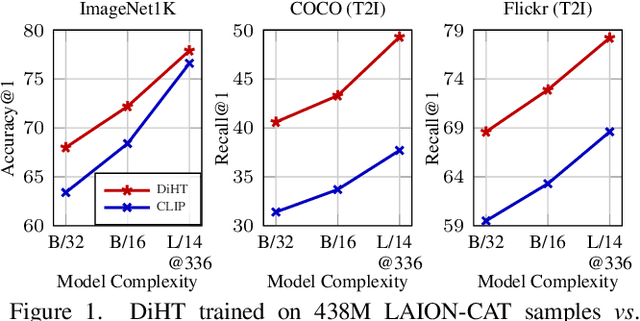
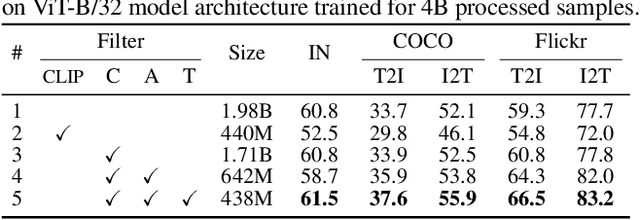
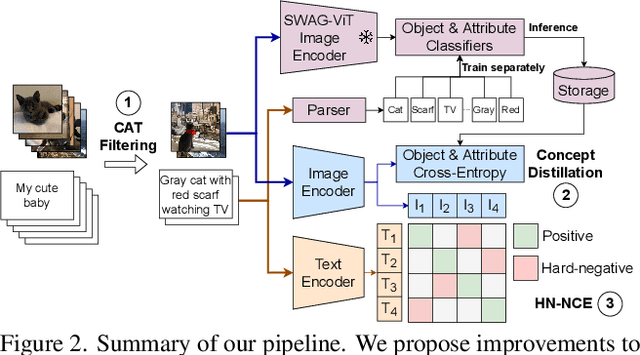
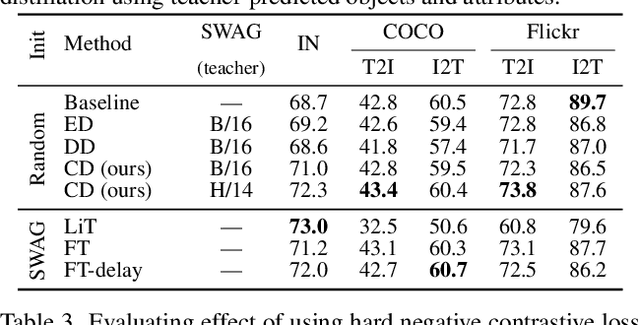
Abstract:Vision-language models trained with contrastive learning on large-scale noisy data are becoming increasingly popular for zero-shot recognition problems. In this paper we improve the following three aspects of the contrastive pre-training pipeline: dataset noise, model initialization and the training objective. First, we propose a straightforward filtering strategy titled Complexity, Action, and Text-spotting (CAT) that significantly reduces dataset size, while achieving improved performance across zero-shot vision-language tasks. Next, we propose an approach titled Concept Distillation to leverage strong unimodal representations for contrastive training that does not increase training complexity while outperforming prior work. Finally, we modify the traditional contrastive alignment objective, and propose an importance-sampling approach to up-sample the importance of hard-negatives without adding additional complexity. On an extensive zero-shot benchmark of 29 tasks, our Distilled and Hard-negative Training (DiHT) approach improves on 20 tasks compared to the baseline. Furthermore, for few-shot linear probing, we propose a novel approach that bridges the gap between zero-shot and few-shot performance, substantially improving over prior work. Models are available at https://github.com/facebookresearch/diht.
PACO: Parts and Attributes of Common Objects
Jan 04, 2023
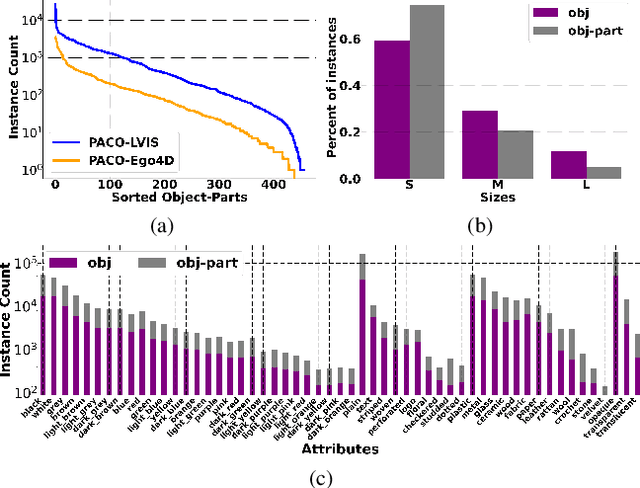
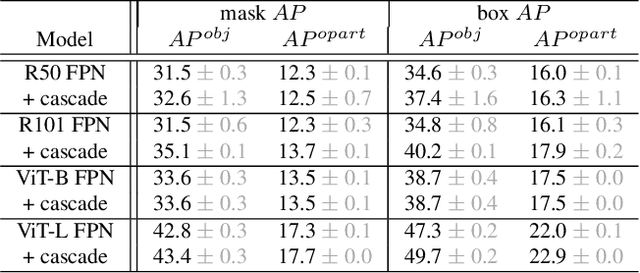

Abstract:Object models are gradually progressing from predicting just category labels to providing detailed descriptions of object instances. This motivates the need for large datasets which go beyond traditional object masks and provide richer annotations such as part masks and attributes. Hence, we introduce PACO: Parts and Attributes of Common Objects. It spans 75 object categories, 456 object-part categories and 55 attributes across image (LVIS) and video (Ego4D) datasets. We provide 641K part masks annotated across 260K object boxes, with roughly half of them exhaustively annotated with attributes as well. We design evaluation metrics and provide benchmark results for three tasks on the dataset: part mask segmentation, object and part attribute prediction and zero-shot instance detection. Dataset, models, and code are open-sourced at https://github.com/facebookresearch/paco.
Event-LSTM: An Unsupervised and Asynchronous Learning-based Representation for Event-based Data
May 10, 2021



Abstract:Event cameras are activity-driven bio-inspired vision sensors, thereby resulting in advantages such as sparsity,high temporal resolution, low latency, and power consumption. Given the different sensing modality of event camera and high quality of conventional vision paradigm, event processing is predominantly solved by transforming the sparse and asynchronous events into 2D grid and subsequently applying standard vision pipelines. Despite the promising results displayed by supervised learning approaches in 2D grid generation, these approaches treat the task in supervised manner. Labeled task specific ground truth event data is challenging to acquire. To overcome this limitation, we propose Event-LSTM, an unsupervised Auto-Encoder architecture made up of LSTM layers as a promising alternative to learn 2D grid representation from event sequence. Compared to competing supervised approaches, ours is a task-agnostic approach ideally suited for the event domain, where task specific labeled data is scarce. We also tailor the proposed solution to exploit asynchronous nature of event stream, which gives it desirable charateristics such as speed invariant and energy-efficient 2D grid generation. Besides, we also push state-of-the-art event de-noising forward by introducing memory into the de-noising process. Evaluations on activity recognition and gesture recognition demonstrate that our approach yields improvement over state-of-the-art approaches, while providing the flexibilty to learn from unlabelled data.
Adaptive Methods for Real-World Domain Generalization
Mar 30, 2021



Abstract:Invariant approaches have been remarkably successful in tackling the problem of domain generalization, where the objective is to perform inference on data distributions different from those used in training. In our work, we investigate whether it is possible to leverage domain information from the unseen test samples themselves. We propose a domain-adaptive approach consisting of two steps: a) we first learn a discriminative domain embedding from unsupervised training examples, and b) use this domain embedding as supplementary information to build a domain-adaptive model, that takes both the input as well as its domain into account while making predictions. For unseen domains, our method simply uses few unlabelled test examples to construct the domain embedding. This enables adaptive classification on any unseen domain. Our approach achieves state-of-the-art performance on various domain generalization benchmarks. In addition, we introduce the first real-world, large-scale domain generalization benchmark, Geo-YFCC, containing 1.1M samples over 40 training, 7 validation, and 15 test domains, orders of magnitude larger than prior work. We show that the existing approaches either do not scale to this dataset or underperform compared to the simple baseline of training a model on the union of data from all training domains. In contrast, our approach achieves a significant improvement.
Weakly Supervised Instance Segmentation for Videos with Temporal Mask Consistency
Mar 23, 2021



Abstract:Weakly supervised instance segmentation reduces the cost of annotations required to train models. However, existing approaches which rely only on image-level class labels predominantly suffer from errors due to (a) partial segmentation of objects and (b) missing object predictions. We show that these issues can be better addressed by training with weakly labeled videos instead of images. In videos, motion and temporal consistency of predictions across frames provide complementary signals which can help segmentation. We are the first to explore the use of these video signals to tackle weakly supervised instance segmentation. We propose two ways to leverage this information in our model. First, we adapt inter-pixel relation network (IRN) to effectively incorporate motion information during training. Second, we introduce a new MaskConsist module, which addresses the problem of missing object instances by transferring stable predictions between neighboring frames during training. We demonstrate that both approaches together improve the instance segmentation metric $AP_{50}$ on video frames of two datasets: Youtube-VIS and Cityscapes by $5\%$ and $3\%$ respectively.
What leads to generalization of object proposals?
Aug 13, 2020



Abstract:Object proposal generation is often the first step in many detection models. It is lucrative to train a good proposal model, that generalizes to unseen classes. This could help scaling detection models to larger number of classes with fewer annotations. Motivated by this, we study how a detection model trained on a small set of source classes can provide proposals that generalize to unseen classes. We systematically study the properties of the dataset - visual diversity and label space granularity - required for good generalization. We show the trade-off between using fine-grained labels and coarse labels. We introduce the idea of prototypical classes: a set of sufficient and necessary classes required to train a detection model to obtain generalized proposals in a more data-efficient way. On the Open Images V4 dataset, we show that only 25% of the classes can be selected to form such a prototypical set. The resulting proposals from a model trained with these classes is only 4.3% worse than using all the classes, in terms of average recall (AR). We also demonstrate that Faster R-CNN model leads to better generalization of proposals compared to a single-stage network like RetinaNet.
Activity Driven Weakly Supervised Object Detection
Apr 02, 2019



Abstract:Weakly supervised object detection aims at reducing the amount of supervision required to train detection models. Such models are traditionally learned from images/videos labelled only with the object class and not the object bounding box. In our work, we try to leverage not only the object class labels but also the action labels associated with the data. We show that the action depicted in the image/video can provide strong cues about the location of the associated object. We learn a spatial prior for the object dependent on the action (e.g. "ball" is closer to "leg of the person" in "kicking ball"), and incorporate this prior to simultaneously train a joint object detection and action classification model. We conducted experiments on both video datasets and image datasets to evaluate the performance of our weakly supervised object detection model. Our approach outperformed the current state-of-the-art (SOTA) method by more than 6% in mAP on the Charades video dataset.
 Add to Chrome
Add to Chrome Add to Firefox
Add to Firefox Add to Edge
Add to Edge